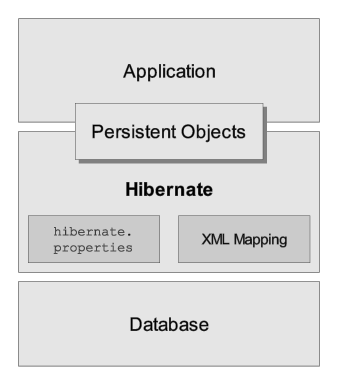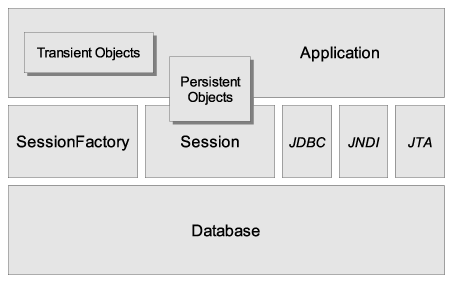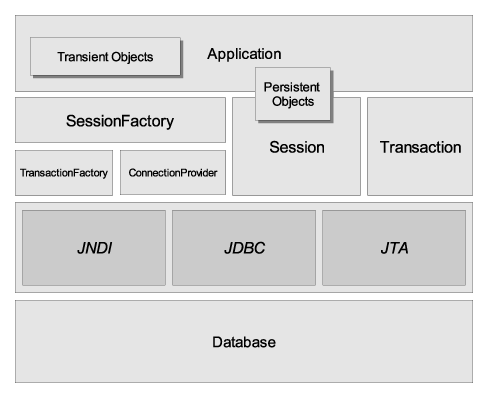Chapter 2. Architecture - Hibernate reference 2.1.8 ga 正式版英文参考手册
A (very) high-level view of the Hibernate architecture:

This diagram shows Hibernate using the database and configuration data to provide persistence services (and persistent objects) to the application.
We would like to show a more detailed view of the runtime architecture. Unfortunately, Hibernate is flexible and supports several approaches. We will show the two extremes. The "lite" architecture has the application provide its own JDBC connections and manage its own transactions. This approach uses a minimal subset of Hibernate's APIs:

The "full cream" architecture abstracts the application away from the underlying JDBC/JTA APIs and lets Hibernate take care of the details.

Heres some definitions of the objects in the diagrams:
- SessionFactory (net.sf.hibernate.SessionFactory)
A threadsafe (immutable) cache of compiled mappings for a single database. A factory for Session and a client of ConnectionProvider. Might hold an optional (second-level) cache of data that is reusable between transactions, at a process- or cluster-level.
- Session (net.sf.hibernate.Session)
A single-threaded, short-lived object representing a conversation between the application and the persistent store. Wraps a JDBC connection. Factory for Transaction. Holds a mandatory (first-level) cache of persistent objects, used when navigating the object graph or looking up objects by identifier.
- Persistent Objects and Collections
Short-lived, single threaded objects containing persistent state and business function. These might be ordinary JavaBeans/POJOs, the only special thing about them is that they are currently associated with (exactly one) Session. As soon as the Session is closed, they will be detached and free to use in any application layer (e.g. directly as data transfer objects to and from presentation).
- Transient Objects and Collections
Instances of persistent classes that are not currently associated with a Session. They may have been instantiated by the application and not (yet) persisted or they may have been instantiated by a closed Session.
- Transaction (net.sf.hibernate.Transaction)
(Optional) A single-threaded, short-lived object used by the application to specify atomic units of work. Abstracts application from underlying JDBC, JTA or CORBA transaction. A Session might span several Transactions in some cases.
- ConnectionProvider (net.sf.hibernate.connection.ConnectionProvider)
(Optional) A factory for (and pool of) JDBC connections. Abstracts application from underlying Datasource or DriverManager. Not exposed to application, but can be extended/implemented by the developer.
- TransactionFactory (net.sf.hibernate.TransactionFactory)
(Optional) A factory for Transaction instances. Not exposed to the application, but can be extended/implemented by the developer.
Given a "lite" architecture, the application bypasses the Transaction/TransactionFactory and/or ConnectionProvider APIs to talk to JTA or JDBC directly.
JMX is the J2EE standard for management of Java components. Hibernate may be managed via a JMX standard MBean but because most application servers do not yet support JMX, Hibernate also affords some non-standard configuration mechanisms.
Please see the Hibernate website for more information on how to configure Hibernate to run as a JMX component inside JBoss.
